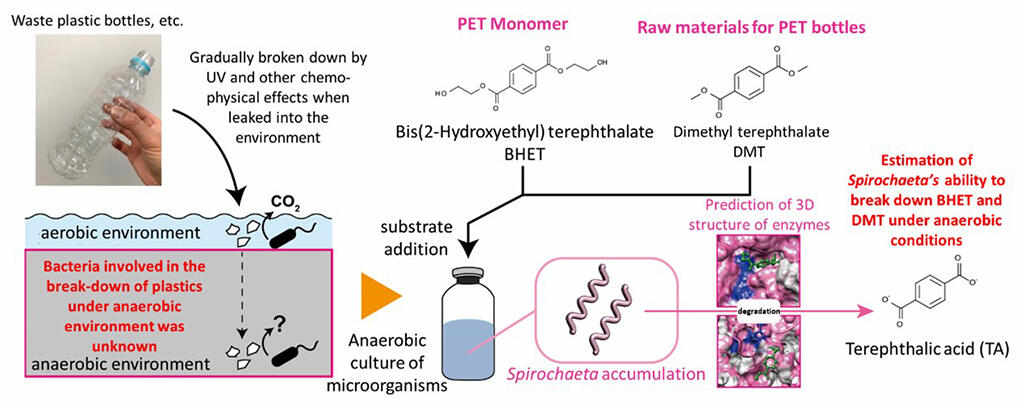A research group led by researcher Takashi Narihiro, researcher Kyohei Kuroda and senior researcher Masaru K. Nobu of the Microbial Ecology and Technology Research Group, Bioproduction Research Institute, National Institute of Advanced Industrial Science and Technology (AIST), announced that it has discovered microorganisms that decompose bis terephthalate (BHET), a polyethylene terephthalate (PET) monomer used in plastic bottles, and dimethyl terephthalate (DMT), a raw material for PET, in an oxygen-free environment. By simulating an anaerobic environment and accumulating and culturing a microbial flora involved in degradation, and measuring metabolites, the group confirmed that BHET and DMT were biodegraded. They also identified the involvement of microorganisms of the phylum Spirochaeta in this degradation. The results are expected to help demystify the dynamics of various plastics scattered throughout the natural world and help develop disposal methods. Their findings were published in the July 5 issue of Chemical Engineering Journal.

Provided by AIST and translated by JST
PET is one of the plastics used in plastic bottles and other containers. There are concerns about the effects of microplastics on humans and living organisms due to their diffusion and fragmentation into tiny pieces in nature. Plastics can degrade in ultraviolet light and through the actions of microorganisms, but most studies have dealt with degradation by aerobic bacteria living in marine surface layers, and degradation in anaerobic environments was not known.
So far, the research group has successfully constructed a lab-scale reactor that can efficiently decompose aromatic compounds including DMT, which are difficult to purify, using complex microbial samples (sludge-derived microbial flora) obtained from wastewater treatment tanks for manufacturing PET bottle products.
As such, in this study, as the decomposition mechanism of BHET and DMT was unknown, a complex microbial sample containing degrading microorganisms was placed in a culture bottle to simulate an anaerobic environment. BHET and DMT were then added as substrates, an enrichment culture was created, and the degraded products were evaluated using a nuclear magnetic resonance apparatus.
The group found that BHET produces monohydroxyethyl terephthalate (BHET) and terephthalic acid (TA), and that DMT produces monomethyl terephthalate (MMT) and TA. They found that BHET and DMT undergo microbial degradation even in anaerobic environments.
Further microscopic observation around the added BHET and DMT crystals revealed spiral-shaped microorganisms that specifically attach to the crystals.
To identify the degradation mechanism, shotgun metagenomic analysis of the complex microbial population in the culture confirmed the presence of new enzymes involved in the degradation of BHET and DMT. Since the enzymes are encoded by a spiral-shaped microorganism belonging to the phylum Spirochaeta, the research group concluded that the microorganism, which belongs to this phylum, degrades BHET and DMT.
A phylogenetically novel microorganism belonging to the phylum Firmicutes in the composite microbial sample was inferred to have a metabolic pathway that degrades ethylene glycol to acetic acid, which is produced during the degradation process of BHET. They also found that methanogenic archaea (archaea) produce methane from methanol produced during the degradation process of DMT.
"In our research, we used PET based materials and targeted microorganisms that grow relatively quickly, but in the future, we would like to change the conditions and study slow-growing microorganisms to see how they respond to PET as well," explains Dr. Kuroda. "We would also like to conduct enzyme-level reaction tests through heterologous expression of the discovered enzymes. By further clarifying the degradation mechanism, we hope to identify how these anaerobic microorganisms acquired this ability, which will lead to the development of technologies that can further contribute to the degradation of microplastics in the environment."
Journal Information
Publication: Chemical Engineering Journal
Title: Elucidation of the biodegradation pathways of bis(2-hydroxyethyl) terephthalate and dimethyl terephthalate under anaerobic conditions revealed by enrichment culture and microbiome analysis
DOI: 10.1016/j.cej.2022.137916
This article has been translated by JST with permission from The Science News Ltd.(https://sci-news.co.jp/). Unauthorized reproduction of the article and photographs is prohibited.




